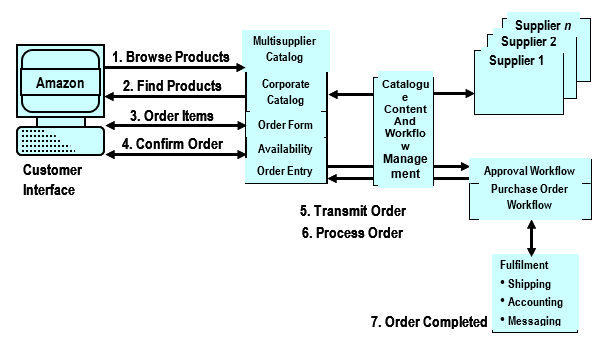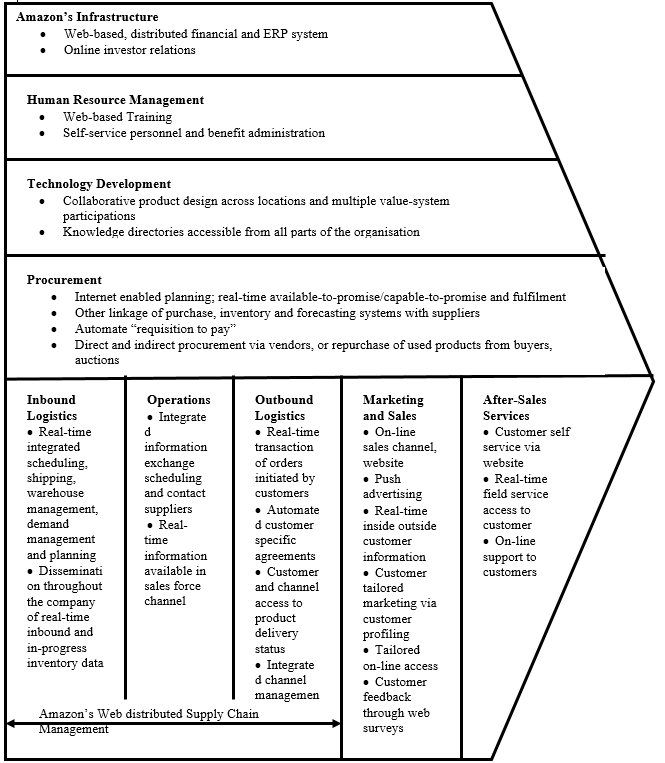Introduction
eBusiness facilitates the virtual supply chain, and as companies manage these virtual networks, it becomes absolutely important to integrate these networks. Firms like Amazon.com are excellent at managing the flow of information and funds, via the Internet and electronic funds transfer as well as to efficiently manage the flow of products. With limited physical inventory on hand at any given time, Amazon has mastered its close ties with wholesalers.
Thus, it has developed one of the most efficient supply chains and through the use of the internet has optimized its value. In addition to books, Amazon expanded into CDs, holiday gifts, including electronics, toys, gadgets, games, etc. Amazon.com substitutes technology for real estate, asserting that, over time, technology gets cheaper while land and physical stores grow more costly. Amazon.com considers its eCommerce system more valuable than the brick-and-mortar of its competitors.
Amazon.com’s business proposition is of delivering of information, goods, or services to end customers employed one strong business model Online Retailers of Physical Goods (School of International Business, 2004). According to Saunders (2001) three operational strategies have helped Amazon.com to enhance its competitive advantage, including cost-leadership, customer differentiation and focus strategies.
The first strategy, cost-leadership is pursued by Amazon.com by differentiating itself on the basis of price. Due to this strategy, Amazon.com always makes sure that it offers the same quality products as other companies for a considerably less price. Their second strategy is customer differentiation. Amazon.com provided current and prospective customers with differentiation through design, quality or convenience and Amazon.com always selects a differentiator that is different from the competitor. So, Amazon.com consumers can recognize and differentiate its product from competitors. The last strategy, focus strategy, take one of the two earlier strategies and applies it to a niche within the market.
This essay aims to understand the supply chain of Amazon.com and its value chain with the aid of Porter’s Value Chain Model.
Business Processes
The business processes (Figure 1(b)) of Amazon.com include customer interface where the customer browses the site and places orders, the order goes to the wholesalers/merchants who send it to Amazon warehouses, payment is made and the order is delivered. The different processes in the workflow of Amazon are as follows:
- Community Building: Author/customer-supplied information related to specific books.
- Sales interface: Direct customer order intake and registration of individual buyers.
- Core information management: Building and providing access to book catalog; building customer database and the value-adding information.
- Core handling and processing: Payment processing, shipping and delivery services.
A key asset is the ability of the firm to build and enhance relationships across the value chain. Customers, authors, publishers and distributors all contribute to the increasing bank of in-house and market information required responding to requests from customers. Customers include those who purchase books, publishers who request market information and book resellers who also rely on Amazon services. The first constitutes business-to-consumer (B2C) e-commerce whereas the latter two are business-to-business (B2B) e-commerce.
The process can diagrammatically be shown as below (Figure 1). The process flow followed by conventional retailers is given in figure 1(a), whereas the one followed by Amazon depends on the order placed by the customer. The workflow of Amazon ensures there is minimum inventory cost and reduces the distribution cost to a great extent.
Figure 1(a) shows the traditional supply chain for a retail set-up, but virtual worlds have made the process less costly and efficient. As in case of Amazon (figure 1(b)), the customer places the order for the product through Amazon’s one-click website.
The selection option given to the customer on the site allows her to choose the product and either save it in the cart or directly send a purchase order. In Amazon’s real-time system the availability order is checked with the specific vendor for the availability of the order and it is then reconfirmed to the customer. This process is followed as Amazon has minimum inventory to reduced inventory cost and get a cost advantage out of the process. Moreover, real-time checking of the availability of the stock reduces time costs for both the customer and Amazon. Then the payment process has completed the order is re-confirmed to the vendor who then is responsible to send the consignment to the customer.


Porter’s Valur Chain
According to Porter(1985) value creation in e-business goes beyond the value that can be realized through the configuration of the value chain, the formation of strategic networks among firms, or the exploitation of firm-specific core competencies (Barney, 1991). As figure 2 shows, Amazon’s value proposition is speed and delivery to doorstep. The core value propositions of Amazon according to Bezos (interview with Taylor, W, 1996) are convenience, selection, service and price. The key business strategy on the new continent is to bypass the value chain and shorten the links to your customer. Professor Porter( 2001) writes, “On the demand side, most buyers will value a combination of online services, personal services, and physical locations over stand-alone Web distribution. They will want a choice of channels…”. This is the advantage that Amazon has derived from its value chain.
Conclusion
Why is Amazon’s strategy much better than brick-and-mortar enterprise? This is because the process is consumer-focused, moving products quickly to the ultimate point of sale based on the most current marketplace knowledge. The process is a seamless integration of the retail supply chain and all members of the supply chain are working towards a common goal (i.e., satisfying the consumer). The plans for all supply chain partners are exactly tailored for their specific needs, are completely relevant and are continuously kept up-to-date. Moreover, the value proposition to is much more integrated and less costly than the other counterpart. Thus Amazon’s core competency lies in offering physical products through virtual space.
Figure 2

References
- Amazon.com. 2008. Web.
- Saunders, R. (2001) Business The Amazon.com, UK: Capstone Publishing Limited, ISBN 184112155X.
- Porter, M (2001) Strategy and the Internet, Harvard Business Review.
- Poretr, M, Miller, V(1985) How Information Gives You Competitive Advantage, Harvard Business Review.
- Barney, J.B., (1991), Firm Resources and Sustained Competitive Advantage. Journal of Management.
- Taylor, William(1996), “Who’s Writing the Book on Web Business?”. Web.
